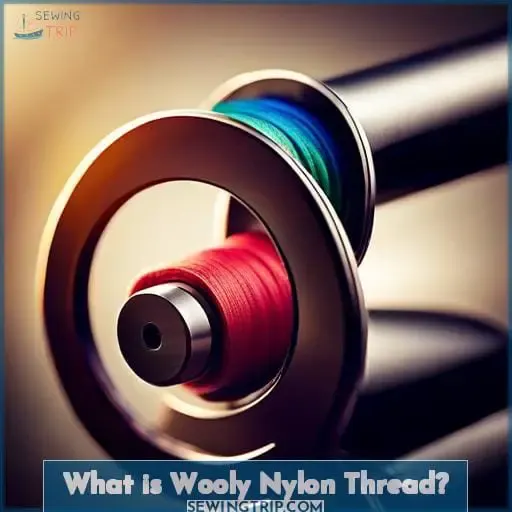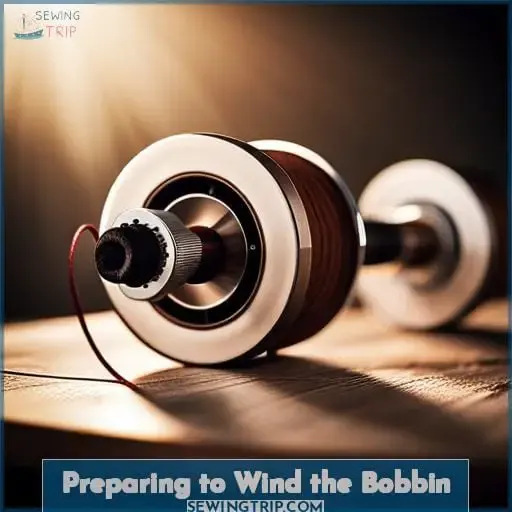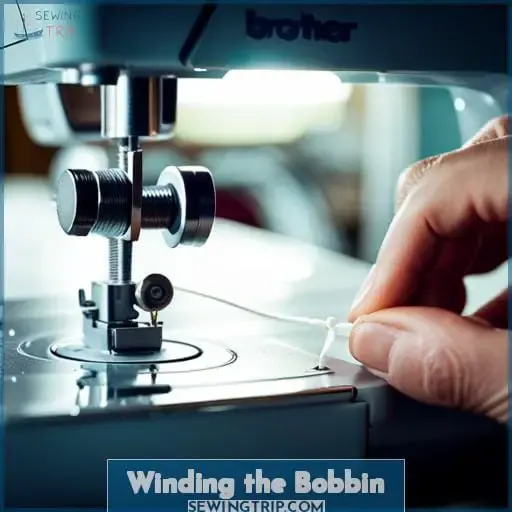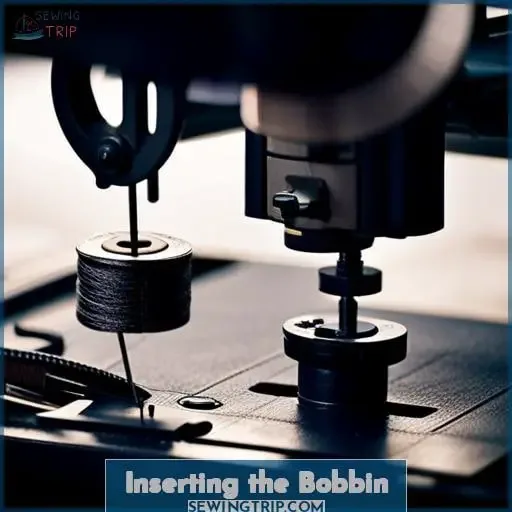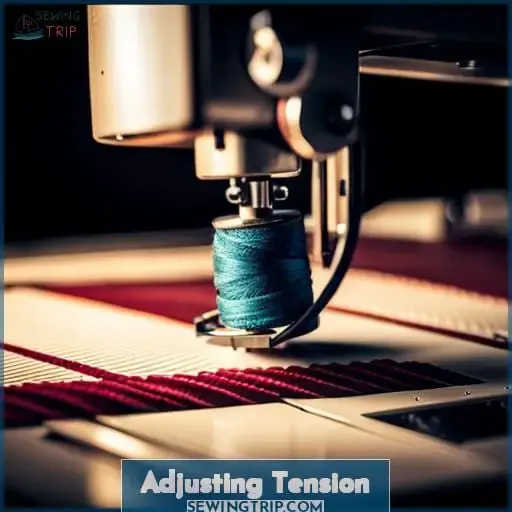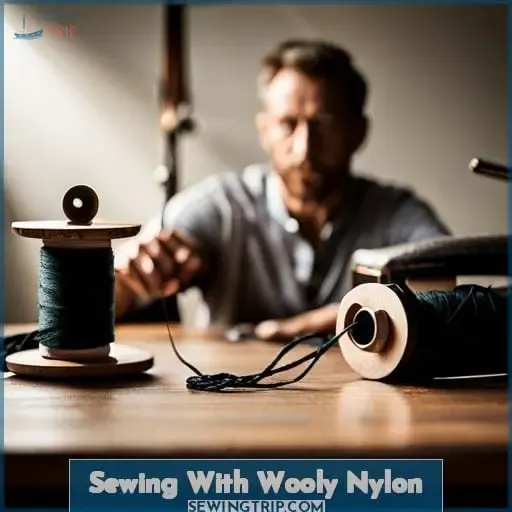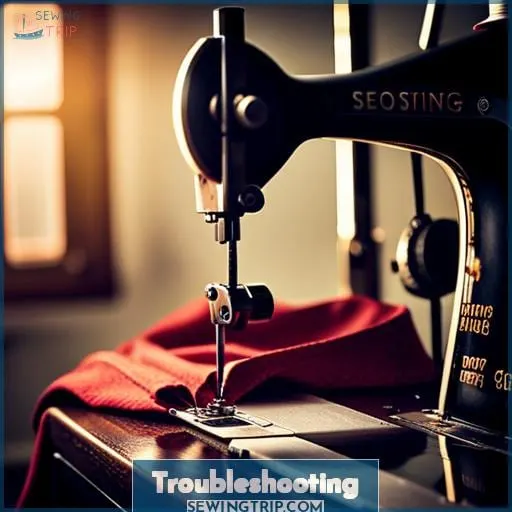This site is supported by our readers. We may earn a commission, at no cost to you, if you purchase through links.
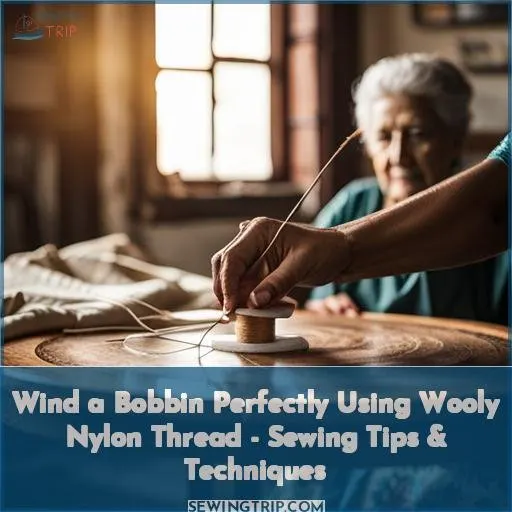 There are crafts you can do while sitting and chatting with friends. Then there’s knitting – a craft so engaging it commands your full attention.
There are crafts you can do while sitting and chatting with friends. Then there’s knitting – a craft so engaging it commands your full attention.
So when working with stretchy wooly nylon thread, you’ll want to wind that bobbin just so. Take your time, winding by hand to control the tension. Keep the spool sideways so the thread pulls easily, moving with care to prevent tangles.
Once wound, insert the bobbin and test your stitching on a fabric scrap. Make any needed tension tweaks before sewing your stretchy knit project.
With the right prep, wooly nylon will become your knitting BFF. Soft, strong, and stretchy, it allows stitches to move without popping seams.
So breathe deep, cast on, and settle in. This thread’s got you covered through row upon blissful row.
Table Of Contents
Key Takeaways
- Use a thread stand to prevent tangles when winding the wooly nylon thread onto the bobbin.
- Wind the thread slowly and evenly by hand onto the bobbin to control tension and prevent lumps.
- Fill the bobbin symmetrically, winding the thread smoothly around the center without overfilling.
- Test stitching on a scrap of fabric after inserting the wound bobbin to check tension settings before sewing your project.
What is Wooly Nylon Thread?
When you’re ready to wind that bobbin, wooly nylon’s stretchy fibers and durability make it ideal for knits and swimwear. Trusted brands like Maxi-Lock and ThreadArt offer the woolly in a range of weights, with regular around tex 24.
With the right tools and techniques, wooly nylon creates smooth seams that move with the fabric.
Properties and Uses
You’re wanting to use this special thread for sewing stretchy fabrics, aren’t you? Wooly nylon is perfect for stretch fabrics like spandex, swimwear, and athletic wear. It has more give and elasticity than regular all-purpose threads, making it ideal for hemming, seaming, and finishing edges on super stretchy knits.
Wooly nylon comes in limited colors like white, black, and variegated. It has a fluffy, fuzzy texture before sewing, and is primarily sold on cones for sergers. While more expensive than regular thread, wooly nylon holds up better to the stress of stretch fabrics.
Use it in the loopers of a serger or in the bobbin of a regular machine when sewing with knits.
- Seaming swimsuits and athletic wear
- Hemming super stretchy knits
- Overlocking seam allowances
- Twin needle hemming on knits
Brands and Weights
Popular brands like ThreadArt and MaxiLock offer wooly nylon in a range of weights, so find the one that’ll give your stretchy projects the perfect amount of elasticity. For lightweight knits, use the standard 23-24 tex weight that resembles 40-weight polyester thread.
Heavier knits may need a bulkier 18 tex wooly nylon with more stretch for seaming without distortion. Test your selected weight first by winding a bobbin slowly by hand and sewing on scraps before using it on your actual project.
Adjust the stitch length to prevent too much stretch in the seams. A longer 3 mm stitch often prevents tunneling or puckering. Take care not to over-press the wooly nylon seams as the thread can melt. With the right wooly nylon weight for your fabric, you’ll get lasting seams that move with the stretch.
Preparing to Wind the Bobbin
When working with wooly nylon’s stretchy fibers, guiding the thread smoothly is key for winding the bobbin. Use a thread stand and carefully feed the wooly nylon by hand onto the bobbin to prevent tangles or breaks.
This hands-on approach will help you evenly wind the wooly nylon bobbin without extra tension for your stretch stitch sewing projects.
Thread Stand
A sturdy thread stand lets the woolly spin freely. Set your spool of woolly nylon onto the stand’s spindle so it can unwind without restriction.
Guide the woolly by hand as it feeds onto the bobbin. Wind slowly and evenly to get a balanced, lint-free fill. For best results, remove the bobbin case from the machine so no tension discs impede the winding.
Once wrapped, insert the bobbin into the case and reset the tension as usual. On stretchy fabrics, wooly nylon creates happy stitches without fabric-stretching frustration.
With gentle winding, the bobbin’s woolly will be ready to softly sew.
Guide by Hand
Guide the soft woolly gently by hand as it unwinds onto the bobbin, for haste makes waste. Let the fuzzy thread spin freely between your fingertips, feeling its softness. Avoid pulling or dragging the strands to prevent snags.
Keep the spool turning steadily, smoothly wrapping the woolly around the bobbin’s center. Monitor the thickness, aiming for an even layer without lumps. Pause periodically to check the sides, making sure it fills out symmetrically.
Stay focused on the winding, keeping other threads untangled. When the bobbin looks full, stop before overfilling. Carefully remove it, then reset the tension for sewing. With practice, you’ll wind woolly nylon like a pro for beautiful stitches on stretchy fabrics.
Winding the Bobbin
Hold the loose wooly nylon thread gently while slowly turning the bobbin by hand to wind it evenly without extra tension. When winding a bobbin with wooly nylon thread, it’s important to guide it carefully to prevent tangles or breaks in the stretchy fibers.
Set your sewing machine to the bobbin winding position and place an empty bobbin on the spindle.
Take the end of the wooly nylon thread and hold it in your fingers right next to the bobbin.
Turn the bobbin slowly and smoothly with your other hand, letting the wooly nylon thread feed onto the bobbin through your fingers.
Wind the bobbin at a steady, moderate speed while gently holding the thread to fill the bobbin evenly from end to end. Avoid winding too tightly or quickly, as this can over-stretch the wooly nylon fibers.
Check that the thread is winding smoothly without fraying or gaps between the coils. When the bobbin is fully wound, run your finger along the side to ensure it’s filled evenly with no bumps. Now your wooly nylon bobbin is ready to create happy stitches on stretchy knit fabrics! Just be sure to insert it properly into the bobbin case and balance the machine tension before sewing your next garment.
Inserting the Bobbin
Neatly slide your fully-wound wooly nylon bobbin into the bobbin case as normal, dear friend. Take care not to over-stuff the works. Gently guide the thread through the tension spring and pull it snug but not tight.
Too much tension here can break the stretchy thread or cause puckering when sewing. Double check your bobbin’s inserted correctly and locks into place. Test on a scrap before sewing your project.
Now set your stitch length to 3 mm or longer using the stitch selector. Lengthening the stitch with wooly nylon prevents elongation of the knit fabric as you sew. Play with the settings on a test piece until you achieve a nice, balanced stitch.
With the ideal tension dialed in, you’ll smile with satisfaction when you see those tiny stitches grabbing the wooly nylon bobbin thread. The resulting seams lie flat and move beautifully with the stretch fabric. No more popped seams while wearing your handmade athleticwear.
Give yourself a pat on the back for mastering suitable techniques for stretch materials.
| Tension Tips | Troubleshooting | Results |
|---|---|---|
| Adjust top tension | Skipped stitches | Smooth stitching |
| Loosen gradually | Fabric puckering | Fabulous seams |
| Check bobbin tension | Thread breaks | Happy stitches |
| Balance settings | Uneven stitching | No popped seams |
Adjusting Tension
When working with stretchy, woolly nylon bobbin thread, you’ll want to carefully tweak your sewing machine’s top tension. Make small turns of the tension dial and test stitch on scrap fabric before sewing your project.
Finding the right balance prevents puckering, skipped stitches, and thread breaks on your stretch knits.
Top Tension
Relax your top tension a tad when usin’ wooly in the bobbin, friend. Too tight and the stretchy thread down below gets all scrunched up.
Wind wooly slow and by hand for supreme stretch. Then use regular polyester thread on top and set stitch width just a hair wider.
Guide your knit gently through the course guides, lettin’ the feed dogs do their work.
Remove any sneaky lint from the bobbin case before ya start. Uneven stitches begone!
With a bit of trial and error, you’ll master the tension to sew heavenly hems that hug those curves oh so right.
Happy sewin’, buddy.
Test Stitching
Make a test stitch before committin’ to your project, friend. It’ll save you headaches down the line.
- Check tension balance between top and bobbin.
- Use scraps of the same fabric if possible.
- Mimic your planned stitch length and type.
- Note any puckering or waving of fabric.
- Adjust machine settings until sample is just right.
Fuss with the test piece first so your final stitches sing. Tweak thread tension, stitch length and presser foot pressure until the knit fabric glides smooth as butter.
Give the sample a good tug in all directions. Make any tweaks so them threads lock together snug but not too tight.
Sewing With Wooly Nylon
Grab an empty bobbin and your cone of wooly nylon thread. Slowly wind the fuzzy thread by hand onto the bobbin, without letting the spool spin too fast, to prevent excess tension.
Twin Needle
You’ll fancy a twin needle for knits when using woolly in the bobbin. With a twin, you get two lines of straight stitching for hems and embellishment on your knit sewing projects.
| Pros | Cons |
|---|---|
| Prevents tunneling on hems | Requires second spool holder |
| Mimics a coverstitch | Not all machines can use twins |
| Adds decorative stitching | Possible skipped stitches |
| Strengthens stretchy seams | Need stretch needle too |
Having two top threads with the woolly nylon bobbin balances the stretch and maintains the fabric’s integrity. Experiment with twin needle samples before sewing your knit garment pieces. Adjust tension and stitch length for best results.
The twin needle and woolly combo will give your stretch hems and seams a professional finish.
Hemming Knits
When hemming knits, gently fold the edge twice and pin before sewing a zigzag stitch. Keep your stitches small and close together, about 1.5-2mm long, as you zigzag along the inner folded hem edge. Match your thread color closely to the garment to make it nearly invisible. Use an embroidery or twin needle and wooly nylon in the bobbin for the best stretch and recovery.
Start with a scrap sample to check stitch settings before hemming your knit garment.
Lettuce edging and narrow rolled hems need specialty machines, but you can mimic them somewhat with zigzag. Take your time guiding the hem without stretching or distorting the knit fabric’s natural shape.
Follow up with a gentle press cloth ironing so seams lay flat without flattening them completely.
Properly hemmed knits move with you while keeping their form.
Troubleshooting
Troubleshooting
Let’s discuss troubleshooting common issues when winding a bobbin with woolly nylon thread. Skipping stitches and puckering fabric are two things to watch for. Check your machine setup and thread quality if you notice these problems while test sewing with the woolly nylon bobbin.
Skipping Stitches
Skipping stitches? Before you start sewin’, check that needle’s pushed up as far as can be.
- Make sure needle size matches thread weight. Too small needles skip more.
- Check bobbin’s wound smooth and moves freely in case.
- Are fabric layers shiftin’ under pressure foot? Keep ’em steady.
- Is top thread tension too tight? Give it some slack if so.
- Are you usin’ the best needle ‘n thread combo for that fabric? Polyester thread, stretch needle for knits prevents skipped stitches.
Whether it’s the needle, bobbin, thread or fabric causin’ those pesky skipped stitches, a few quick checks’ll get your machine back to sewin’ smooth.
Puckering Fabric
Check that foot pressure’s balanced if the fabric’s bunchin’ up. Too much pressure’ll push layers unevenly, causin’ gathers. Try lightenin’ it up some. When hemming knits like swimsuit fabric, puckering’s extra noticeable – that rolled edge technique needs smooth seams.
For lightweight cottons, decorative stretch stitches make ’em pucker too. Pop in a twin needle, loosen the top tension, lengthen that stitch a tad.
The right thread and bobbin combo helps stop puckers in their tracks – like wooly nylon thread for super stretchy fabrics.
Puckers slow ya down but you’ll get that fabric sewn smooth in no time.
Frequently Asked Questions (FAQs)
What size/weight of wooly nylon thread should I use?
Use a medium-weight nylon thread like YLI Wooly Nylon # You’ll feel it slide smoothly through your fingers before winding onto the bobbin. This thicker thread handles stretch stitches beautifully without breaking. For lightweight knits, try a finer #60 nylon.
Can I wind a wooly nylon bobbin on my sewing machine instead of by hand?
You can try, but hand winding is best for wooly nylon. The tension disks may shred the fuzzy thread if the winder grips too tightly. Guide it slowly by hand onto the bobbin to keep the fibers smooth. This prevents problems when sewing knits later.
How do I know if my sewing machine tension is set correctly for wooly nylon thread?
You’ll know if your tension is set properly when the stitches look balanced on both sides of the fabric. Make small adjustments and test on scrap material. Tighten the top tension if the bottom looks loose.
Loosen the top tension if the top thread is pulling too tight. Check for even, slightly visible stitches without puckers.
What stitch settings should I use when sewing with wooly nylon thread?
Use a longer stitch length of around 3mm. Slightly loosen the top tension. Consider using a stretch stitch or lightning stitch. Adjust settings as needed until the stitches look balanced without puckering the fabric.
Can I use wooly nylon thread in the needle of my sewing machine or just in the bobbin?
You should only use wooly nylon thread in the bobbin of your sewing machine. Using it in the needle can cause skipped stitches, shredding, and thread jams. Insert the wound wooly nylon bobbin into the bobbin case, and thread the top of your machine with regular all-purpose thread instead.
Conclusion
Sewing with wooly nylon thread will revolutionize your knit garment creations! You’ll be amazed at how perfectly it prevents puckering and gapping on stretchy hems. So follow these bobbin winding steps, and wooly nylon will become your new best friend for knit sewing success! Expertly winding the bobbin is the key first step before enjoying wooly nylon’s magical properties on knits.
With some practice, you’ll become a pro at winding and sewing with wooly nylon in no time.

